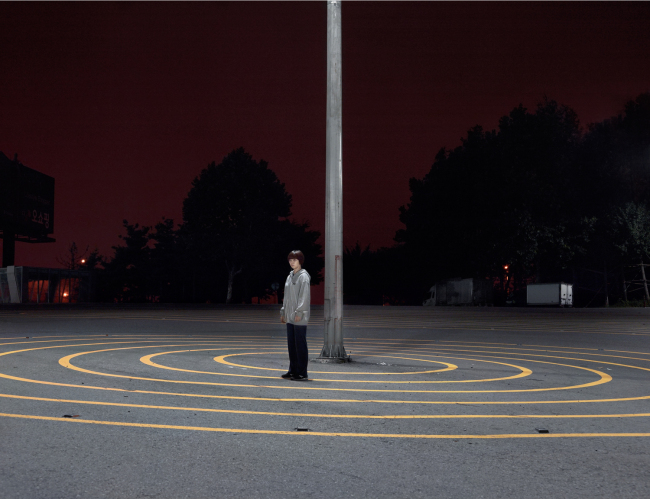Photos outline Korean identity
Touring exhibition presents images of Korea that capture its people, cities, history and landscapes
By Lee Woo-youngPublished : Dec. 9, 2013 - 19:33

Photography is one of the most common and popular mediums of art enjoyed by Koreans. It’s not unusual to see people hold a digital camera in one hand and take a “selfie,” which then goes instantly online on micro blogs or social networking sites.
While such popularity has undermined the value of photography as a genre of art, fine art photographers in Korea have been capturing what individual amateur photographers miss.
A touring photo exhibition brings together images that reflect changes in Korean society at four museums in Daejeon, Changwon, Gwangju and Seoul until April 2014. There will be slight variations in the featured photographs in each city but the most important works will be shown in all four.
“We hope the exhibition introduces as many professional photographers as possible to the public and shows the diverse aspects of Korea,” said Park Ju-seok, head of the committee for the Festival of Photography in Museums, the first festival of its kind.
Each exhibition sheds light on different aspects of Korea ― society, people, history and the cities ― under the common theme “Photography tells Korea.”
“The exhibitions focus on the regional characteristics. The Gwangju exhibition examines its turbulent modern history and Changwon focuses on the expansion of cities drawing on the experience of merging with the neighboring cities of Masan and Jinhae,” said Park.
Some of the highlights include Kang Hong-gu’s portrayal of a Changwon neighborhood about to be rebuilt amid the city’s redevelopment plans. The photo “Love for My Home” shows a house with the phrases “I love my home” and “Protest” displayed in red lacquer as a sign of disapproval of the city redevelopment plan.
Joo Myung Duck’s “Mixed-race children” shows racially mixed orphans at Holt Orphanage as a much neglected part of Korean society. The first generation documentary photographer has documented moments of modern Korean history that capture marginalized people, cultures and landscapes.
A portrait of a soldier by Lee Sang-yeop highlights the unique aspect of society stemming from the division of the country and the tension over the possibilities of war.
The first exhibition, open from Friday to Feb. 26 at Daejeon Museum of Art, highlights the dynamism of Korean society with pictures depicting communities and citizens. The second exhibition, scheduled from Jan. 16 to April 16, 2014, at Gyeongnam Art Museum in Changwon will present images taken as evidence of the flourishing city development along with the gloomy side of modernization.
The Gwangju exhibition from Feb. 4 to April 14, 2014 at Gwangju Art Museum will include recreations of images based on memories of historical facts and imagination.
The Seoul exhibition at Seoul Museum of Arts from Jan. 28 to March 23 will show diverse works, ranging from fine art photographs, media photos and advertizing photos, associated with the city’s high technology.
Accompanying lectures and seminars will be held at Arko Center in Daehangno, Seoul.
For more information, visit www.festivalofphotographyinmuseums.com.
By Lee Woo-young
(wylee@heraldcorp.com)
While such popularity has undermined the value of photography as a genre of art, fine art photographers in Korea have been capturing what individual amateur photographers miss.
A touring photo exhibition brings together images that reflect changes in Korean society at four museums in Daejeon, Changwon, Gwangju and Seoul until April 2014. There will be slight variations in the featured photographs in each city but the most important works will be shown in all four.
“We hope the exhibition introduces as many professional photographers as possible to the public and shows the diverse aspects of Korea,” said Park Ju-seok, head of the committee for the Festival of Photography in Museums, the first festival of its kind.
Each exhibition sheds light on different aspects of Korea ― society, people, history and the cities ― under the common theme “Photography tells Korea.”
“The exhibitions focus on the regional characteristics. The Gwangju exhibition examines its turbulent modern history and Changwon focuses on the expansion of cities drawing on the experience of merging with the neighboring cities of Masan and Jinhae,” said Park.
Some of the highlights include Kang Hong-gu’s portrayal of a Changwon neighborhood about to be rebuilt amid the city’s redevelopment plans. The photo “Love for My Home” shows a house with the phrases “I love my home” and “Protest” displayed in red lacquer as a sign of disapproval of the city redevelopment plan.
Joo Myung Duck’s “Mixed-race children” shows racially mixed orphans at Holt Orphanage as a much neglected part of Korean society. The first generation documentary photographer has documented moments of modern Korean history that capture marginalized people, cultures and landscapes.
A portrait of a soldier by Lee Sang-yeop highlights the unique aspect of society stemming from the division of the country and the tension over the possibilities of war.
The first exhibition, open from Friday to Feb. 26 at Daejeon Museum of Art, highlights the dynamism of Korean society with pictures depicting communities and citizens. The second exhibition, scheduled from Jan. 16 to April 16, 2014, at Gyeongnam Art Museum in Changwon will present images taken as evidence of the flourishing city development along with the gloomy side of modernization.
The Gwangju exhibition from Feb. 4 to April 14, 2014 at Gwangju Art Museum will include recreations of images based on memories of historical facts and imagination.
The Seoul exhibition at Seoul Museum of Arts from Jan. 28 to March 23 will show diverse works, ranging from fine art photographs, media photos and advertizing photos, associated with the city’s high technology.
Accompanying lectures and seminars will be held at Arko Center in Daehangno, Seoul.
For more information, visit www.festivalofphotographyinmuseums.com.
By Lee Woo-young
(wylee@heraldcorp.com)



















